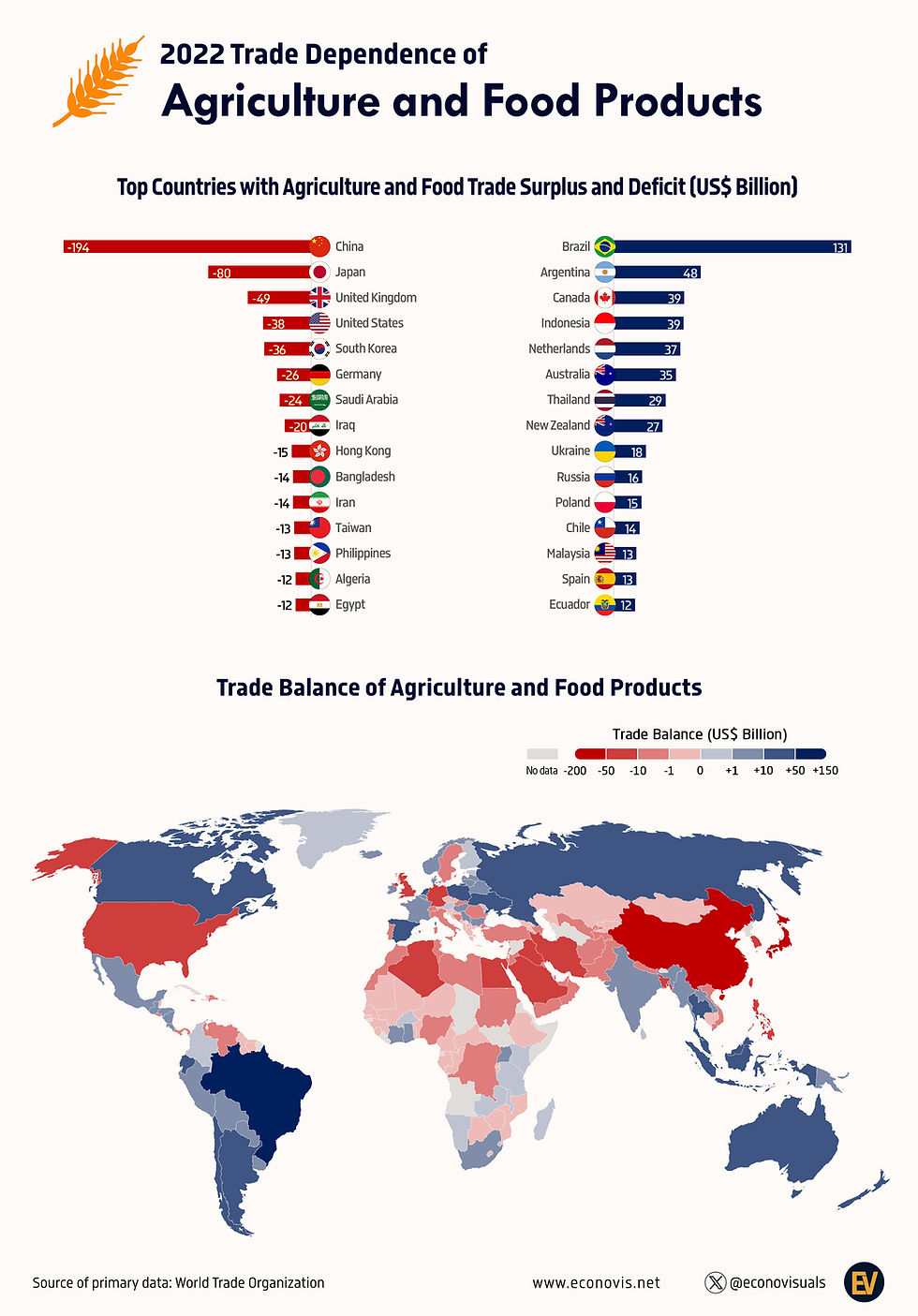Trade Dependence of Agriculture and Food Products: Top Countries with Agriculture and Food Trade Surplus and Deficit
- Admin
- Jun 12, 2024
- 3 min read
Global trade in agriculture and food products experienced a significant surge in 2022, reaching an impressive $4,758 billion. This marked a 31% increase compared to pre-pandemic levels in 2019, reflecting the resilience and growth of the agricultural sector despite the challenges posed by the COVID-19 pandemic. Agriculture and food products made up 9.4% of total global merchandise trade in 2022, underscoring their critical importance in the global economy. Notably, food alone constituted a substantial 86% of this trade, highlighting the pivotal role of food products in agricultural commerce.
A closer examination of the trade balances reveals a diverse landscape. In 2022, 59 countries recorded a trade surplus in agriculture and food products, with each surplus exceeding $100 million. On the other hand, 105 countries experienced a trade deficit in the same category, each also exceeding $100 million. This imbalance indicates varied levels of agricultural production and dependence on food imports across different nations.
Brazil emerged as the global leader in agricultural trade surplus, boasting an astounding $131 billion surplus in 2022. This achievement is largely attributed to Brazil's robust production of commodities such as soybeans, beef, coffee, and sugar. Brazil's extensive arable land, favorable climate, and advanced agricultural practices have positioned it as a powerhouse in the global agricultural market.
Following Brazil, Argentina recorded a significant trade surplus of $48 billion. Argentina's agricultural economy is heavily reliant on exports of soybeans, corn, and wheat. Despite economic challenges, the country has maintained its position as a leading exporter in the agricultural sector.
Other notable countries with substantial agricultural trade surpluses include Canada, Indonesia, the Netherlands, and Australia, each with surpluses ranging from $35 to $39 billion. Canada's surplus is driven by its exports of wheat, canola, and seafood, while Indonesia benefits from palm oil and coffee exports. The Netherlands, despite its small size, is a major exporter of flowers, dairy products, and meat, reflecting its highly efficient agricultural sector. Australia's surplus is bolstered by its exports of beef, wheat, and wool.
Conversely, China recorded the largest trade deficit in agriculture and food products in 2022, totaling a staggering $194 billion. This deficit is indicative of China's immense demand for food imports to meet the needs of its large population. Despite being a major agricultural producer, China's rapid urbanization and dietary changes have increased its reliance on imported food products.
Japan followed with a trade deficit of $80 billion, driven by its dependence on imports of staple foods such as wheat, corn, and soybeans. The United Kingdom, with a deficit of $40 billion, also relies heavily on food imports due to its relatively limited agricultural production. The United States recorded a trade deficit of $38 billion in agriculture and food products, which may seem surprising given its large agricultural sector. This deficit reflects the country's substantial imports of tropical products such as coffee, cocoa, and bananas, which are not produced domestically in significant quantities.
South Korea and Germany also reported significant trade deficits in agriculture and food products, with deficits of $36 billion and $26 billion, respectively. Both countries have limited arable land relative to their population sizes, necessitating substantial food imports to meet domestic demand.
Overall, the global trade landscape for agriculture and food products in 2022 highlights the varying capacities of countries to produce and export food, as well as their differing levels of dependence on imports. The significant increases in trade values since 2019 underscore the growing importance of agricultural trade in the global economy, driven by factors such as population growth, dietary changes, and advancements in agricultural technology.

-.png)
Comments